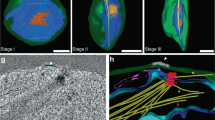Abstract
The fine structure of nuclear division in the hemoflagellate Trypanosoma cruzi has been studied with serial sections and three-dimensional reconstructions of each divisional stage. After a preliminary stage in which the chromatin becomes dispersed, there is an equatorial stage defined by the appearance of an arranged set of ten dense plaques located about the equatorial region of the nucleus. At this stage a regular microtubular spindle is formed in the nucleus. Each plaque has a symmetrical structure formed by transverse bands and the bands are formed by tightly packed fibrillar material. The wide faces of the plaques are associated with tangential microtubules coming from the poles while the front and rear edges are free to associate with chromatin. Although structural continuity between chromatin fibers and the material of the plaques is possible, this continuity has not been proved. The equatorial spindle is formed by about 120 microtubules arranged in two sets of about 60 microtubules running from each pole to the dense plaques and divided into discrete bundles which reach a single plaque. The microtubules of each bundle may pass tangential to the wide faces of the plaque and end about 0.2 μm beyond it, or they may end at the pole-facing edges of the plaque. No continuous, interpolar microtubules were observed at this stage. At the beginning of the elongational stage the dense plaques split into halves and each set of half-plaques migrates to one pole. During mid-elongational stage the pole-converging microtubules and the polar bulges disappear and microtubules become rearranged between the two sets of half-plaques. During late elongational stages, continuous microtubules run between the two sets of half-plaques and maximum nuclear elongation is attained. Chromatin remains dispersed throughout nuclear division. Two main movements have been observed in these mitotic nuclei: the migration of half-plaques to the poles and the elongation of the nucleus. Both these movements are accompanied by large changes in the architecture of the microtubular spindle and are probably dependent on microtubular function. It is concluded that the dense plaques play a kinetochore-like role and thus T. cruzi would have ten chromosomal units.
Similar content being viewed by others
References
Brack, C.: Elektronmikrokopische Untersuchungen zum Lebenzyklus von Trypanosoma cruzi. Acta Tropica (Basel) 25, 289–356 (1968)
Bianchi, L., Rondanelli, E.G., Carosi, G., Gerna, G.: Endonuclear spindle in the leptomonad of Leishmania tropica. J. Parasitol. 55, 1091–1903 (1969)
Byers, B., Goetsch, L.: Electron microscopic observations on the meiotic karyotype of diploid and tetraploid Saccharomyces cerevisae. Proc. Nat. Acad. Sci. (Wash.) 72, 5056–5060 (1975)
De Souza, W., Meyer, H.: On the fine structure of the nucleus in Trypanosoma cruzi in tissue culture forms. Spindle fibers in the dividing nucleus. J. Protozool. 21, 48–52 (1974)
Franke, W.W., Reau, P.: The mitotic apparatus of a Zygomycete, Phycomyces blakesleeanus. Arch. Mikrobiol. 90, 121–130 (1973)
Fuge, H.: The arrangement of microtubules and the attachment of chromosomes to the spindle during anaphase in Tipulid spermatocytes. Chromosoma (Berl.) 45, 245–260 (1974)
Fuge, H.: Ultrastructure of the mitotic spindle. Int. Rev. Cytol., Suppl. 6. 1–58 (1977)
Heath, I.B.: Genome separation mechanisms in prokaryotes, algae and fungi. In: The cell nucleus (H. Busch, ed.) Vol 2, pp. 487–515. New York: Academic Press 1974
Heywood, P., Weinman, D.: Mitosis in the hemoflagellate Trypanosoma cyclops. J. Protozool. 25, 287–293 (1978)
Kubai, D.: Unorthodox mitosis in Triconympha agilis: kinetochore differentiation and chromosome movement. J. Cell Sci. 13, 511–552 (1973)
Kubai, D.: The evolution of the mitotic spindle. Int. Rev. Cytol. 43, 167–227 (1975)
Lu, B.C.: Meiosis in Coprinus. VIII. A time-course study of the fusion and division of the spindle pole body during meiosis. J. Cell Biol. 76, 761–766 (1978)
Moens, P.B., Rapport, E.: Spindles, spindle plaques and meiosis in the yeast Saccharomyces cerevisae (Hansen). J. Cell Biol. 50, 344–361 (1971)
Noble, E.R., McRary, W.L., Beaver, E.T.: Cell division in trypanosomes. Trans. Amer. Microsc. Soc. 72, 236–248 (1953)
Solari, A.J.: The spatial relationship of the X and Y chromosomes during meiotic prophase in mouse spermatocytes. Chromosoma (Berl.) 29, 217–236 (1970)
Tippit, D.H., McDonald, K., Pickett-Heaps, J.D.: Cell division in the centric diatom Melosira varians. Cytobiologie 12, 52–73 (1975)
Vickerman, K., Preston, T.M.: Spindle microtubules in the dividing nuclei of trypanosomes. J. Cell Sci. 6, 365–383 (1970)
Westergaard, M., Wettstein, D. von: The synaptinemal complex. Ann. Rev. Genet. 6, 71–110 (1972)
Author information
Authors and Affiliations
Rights and permissions
About this article
Cite this article
Solari, A.J. The 3-dimensional fine structure of the mitotic spindle in Trypanosoma cruzi . Chromosoma 78, 239–255 (1980). https://doi.org/10.1007/BF00328395
Received:
Accepted:
Issue Date:
DOI: https://doi.org/10.1007/BF00328395




